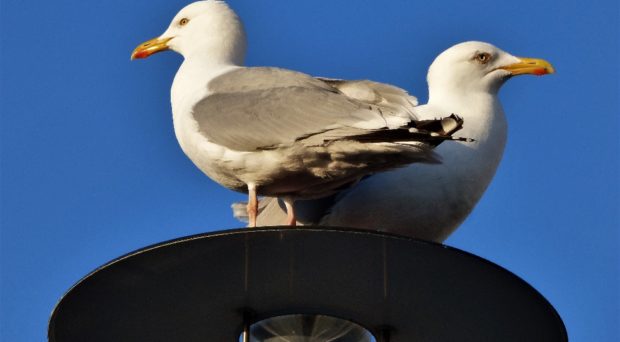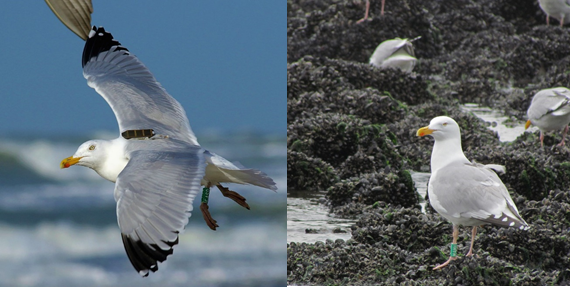
That gulls profit from foods of anthropogenic origin is well known. The herring gull (Larus argentatus: picture 1), a common large gull of the northern hemisphere, gathers foods at refuse dump sites and waste treatment centers, but it also eats the discards of commercial fisheries. However, not all gulls eat anthropogenic foods and visit other, more natural coastal areas instead.
Why animals would make such decisions and what the implications can be on a population level, is explained in a recent publication in Movement Ecology in which herring gulls breeding on Texel, the Netherlands were studied.
The energy balance
ultimately, extra energy a gull has for raising chicks depends on the balance between the energy that goes in and the energy that goes out
Foods of anthropogenic origin are very profitable for gulls, as they are relatively high in terms of energetic value and fill an empty stomach of a gull and its chicks quickly. These foods can therefore have a positive effect on the number of chicks that a gull can raise. However, ultimately, extra energy a gull has for raising chicks depends on the balance between the energy that goes in and the energy that goes out. If the energetic costs are very high, a gull can choose to eat food with a lower energetic value with lower associated costs for obtaining it. To date, little is known about the energetic investments in different food types and how these can influence a gull’s menu decisions.
Gulls with smartphones
Energetic costs of getting food can be a reason for an animal to not just eat fish and chips. But how can we measure energetic expenditure of free-living animals? That is possible by attaching a “smartphone” on the back of the gulls; a small device that measures where an animal is and what it is doing (picture 2). In the same way as your provider can track you through your phone, we follow where the gulls go. In the same way as your phone detects movement to orient the screen, we see the gulls’ movements.
This is possible because every behavior has a specific movement pattern. For instance, when a gull is flying, its body is moving repeatedly up and down. Behaviors differ in energetic costs; an animal that flies with flapping wings spends more energy than an animal that walks while gathering its food.

High energy expenditure
For landfill food and other human waste, gulls have to fly further away from their breeding grounds than for other food items like mussels or earthworms. For fishery discards, gulls have to search and follow fishing fleets, which means that they have to fly over sea in large groups of birds.
The rate of energy expenditure is on average 34% higher when individuals gather mainly high caloric prey of anthropogenic origin
We show that the rate of energy expenditure is on average 34% higher when individuals gather mainly high caloric prey of anthropogenic origin compared to gathering low caloric prey in, for instance, coastal areas. This increase in energy expenditure is comparable to an adult human that changes from a desk-bound job and little movement to a standing job with an active lifestyle.
To compensate for these movement costs, gulls that feed completely on these resources have to gather ~400 kJ food per day more. Such higher costs of gathering food could thus be a good reason to eat lower caloric foods like mussels or earthworms.
Environmental changes
Landfill and fishery regulations have changed and will continue to do so, reducing the availability of anthropogenic food resources. As a result, landfills are disappearing, including one 4 kilometers away from the breeding colony, and regulations around fishery limit the amount of fish discarded, thus increasing the energy costs of gathering food from anthropogenic sources.
‘Stubborn’ individuals
To avoid low breeding results, gulls could adapt their behavior. For instance, by breeding closer to the areas that contain food, like in cities.
Gulls breeding on the island of Texel raise more chicks when feeding them mainly high caloric prey of anthropogenic origin. When the costs of gathering these foods increase, the energy balance of what goes in and what goes out will change, with potentially negative effects on their reproductive success and on the population growth.
To avoid low breeding results, gulls could adapt their behavior. For instance, by breeding closer to the areas that contain food, like in cities. However, many adult herring gulls seem to be quite conservative in their behavior; they generally visit the same places to gather food over and over again and come back to the same breeding grounds.
Although the location of the breeding site on Texel does not seem very favorable anymore in terms the availability of high caloric food, we did not see a decrease in breeding pairs over the last decade. We will now aim to study whether the herring gulls are able to adapt to these human induced changes in the future.
Susanne van Donk
Latest posts by Susanne van Donk (see all)
- Why not all gulls eat fish and chips - 13th June 2019
Comments